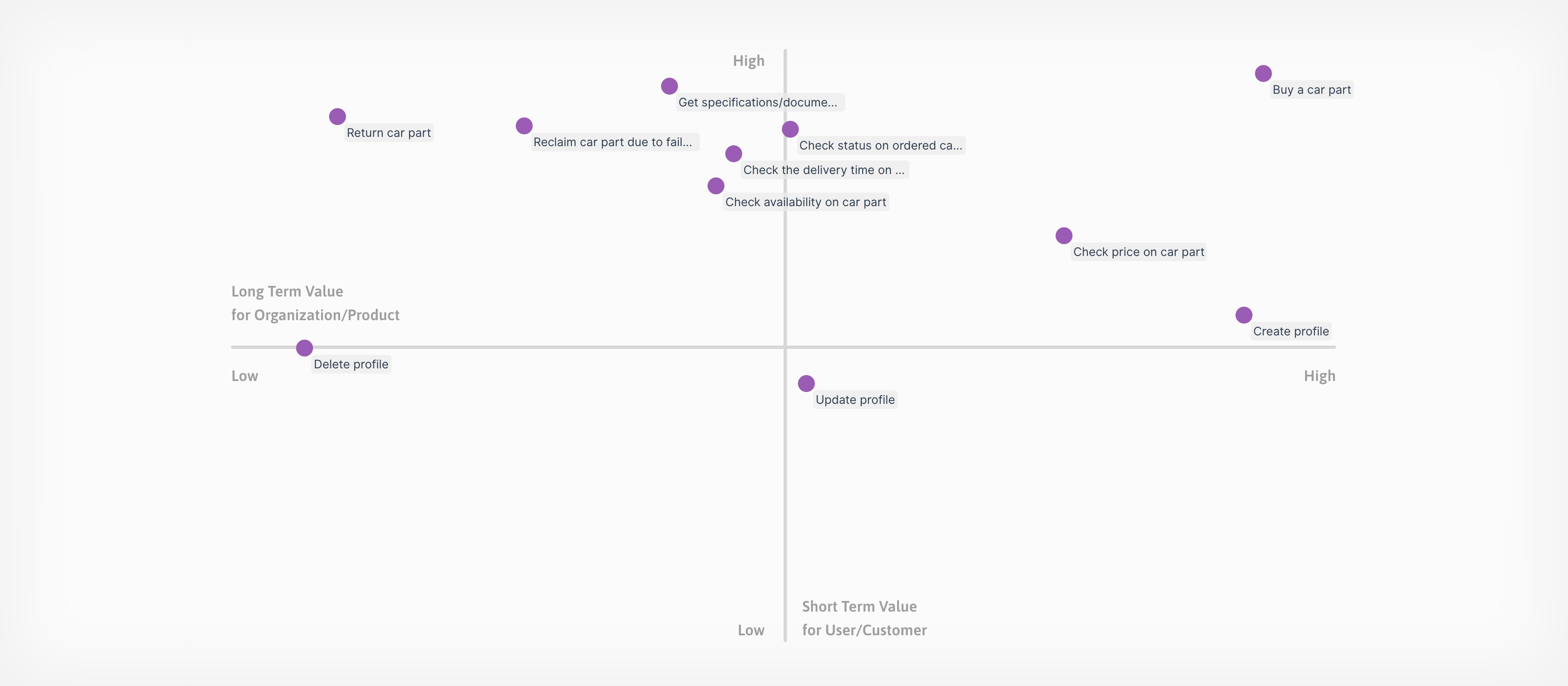The Kickstart Workshop
A fun and easy way to get started with Aiava.


Background
With the Kickstart Workshop, you will get a bird's eye view of your business/organization/product/service. It's a workshop to prioritize what matters most to your company/organization and your customers/users. The result from this workshop will serve as a starting point to dig down and get your customer's journey right with the Aiava framework.
You don't need any prior knowledge of Aiava to run this workshop. Everything will be explained in detail in this article. When the Kickstart Workshop is wrapped up, we strongly recommend that you read the Aiava Academy articles in the Knowledge Base available after login.
The Kickstart Workshop comes with a handy tool available after login. Find it inside every project, below "Tools & Analysis" in the left menu. You will get a 14 days free trial on your first Aiava project, so you can run this workshop completely free.
The team or person executing this workshop should have in-depth knowledge of the business/organization/product/service you are working with. It is also desirable to have different departments and competence represented in the team.
The Aiava Framework
Aiava provides a framework to model the universe around your business/organization/product/service. This universe includes:
- Actors: the customer/user, apps, servers, your company, your Support Dept. etc.
- The actors communicate with each other through channels: interaction on a screen, email, by phone, etc.
- The actors create, use, modifies and send things: documents, data, packages, etc.
- The actors perform tasks where they handle things, often in collaboration with other actors through channels.
- When we map how tasks are performed, we build journeys.
In this workshop, we are aiming at identifying the tasks. The next step will be to map the journeys.
1. Define the scope
First, we define our model's scope, or in Aiava terms, the center of the universe.
Here are some examples:
- a service
- an app
- a portal
- a system
- a webpage
- a business
- an organization
For convenience, we will call it your company from now.
Next, we define our target group. Who are the users/customers/clients of your company? If you have different groups/segments, it can be smart to focus on one group at a time.
For convenience, we call them our customers instead of target group/users/customers/clients from now on.
If you haven't already done it, create a project in Aiava. The name of your company (we call it company from now on, remember?) is typically the Aiava project title.
2. Create the list of tasks
When we have defined the scope, we are ready to create a list of the tasks in our universe. Creating this list at this stage is an exercise to get as much as possible on the table.
A way to work with this is to step into the shoes of the customer and answer this question:
As the customer approaches your company, what can be on their mind – what kind of tasks do they want to solve?
Other questions to help you get started:
- What does your company offer? Not necessarily what the customers want, but include them anyway.
- What kind of information do your customers try to find?
Let's make it clearer with a couple of examples.
Example 1: List of tasks for e-commerce for car parts
- Buy a car part
- Check availability on car part
- Check status on ordered car part
- Update profile
- Check the delivery time on the car part
- Update address on profile
- Get specifications on car part
- Update contact info on profile
- Create profile
- Delete profile
- Log in
- Find documentation on car part
- Return car part
- Reclaim car part due to failure
- Check price on car part
Example 2: List of tasks for an insurance company
- Become customer
- Buy insurance
- Transfer insurances from a different insurance company
- Check the monthly cost
- Report incident
- Follow up after an incident
- Check terms of insurance
- Register new item for insurance
- Terminate insurance
When you build the list, use the Kickstart Tool's right drawer. Each task in the list can be rearranged using drag and drop.

You will probably get a decent list of tasks just by picking tasks from the top of your head. Some other techniques include:
- Looking into search logs in your apps and webpages.
- Asking support; what kind of problems are you helping customers solve?
- Asking customers: what do you expect our company to deliver?
3. Refine the list
When the list is settled, it's time for a review to refine the list.
Combine
Is it possible to combine any of the tasks? Example 1, "Get specifications on car part" and "Find documentation on car part" are good candidates. Example 2, "Become a customer" and "Buy insurance" is basically the same thing. Maybe we can join them in "Buy insurance and become a customer".
Skip
Are any of the tasks a part of other tasks? In example 1, "Log in" is hardly a task worth mentioning at this stage. Logging in is probably just a step on the path to solving other tasks, e.g. "Check status on ordered car part". Consider skipping tasks like "Log in". They will emerge deeper inside the universe as we start to dig into different tasks.
Rephrase
Do a brief scan of the task names. Are they consistent? Could the names be shortened or rephrased to be more concise?
4. Prioritize
When the list is settled and refined, it's time to prioritize each task into four quadrants:
- Upper right: high value for the company – high value for customers
- Lower right: high value for the company – low value for customers
- Lower left: low value for the company – low value for customers
- Upper left: low value for the company – high value for customers

When the tasks are on the chart, use some time to consider where to position them. If you have a team to play ball with, use the chart to settle a common understanding within the team.
The axis
The four quadrants are separated by two axes with a low to high span. The horizontal axis is labeled "Long term value for Company". So, by positioning each task along this axis we state to what degree does this task provide long term value for the company.
What is value for a company? It depends on what kind of industry you are operating in. Here are some suggestions:
- Revenue (corporate businesses)
- Fulfilling the vision set by the board (NGOs, organizations, etc.)
- Fulfilling the mandate given by the authority (governments, municipalities, etc.)
The vertical axis is labeled "Short term value for User/Customer". Again: to what degree does this task provide short-term value for the customer.
What is value for the customer? Depending on what your company has to offer, here are some suggestions:
- You're solving problems for customers
- You're providing valuable services for your customers
- You're offering valuable information, enabling customers to make better choices
The axis labels are maybe a bit opinionated. In our view, to run a successful company, you must have a long-term perspective on building value for the company, and you must be able to provide short-term value for the customer. If you disagree with this, or it just doesn't suit your company, feel free to think differently about these axes.
Analysis
When the tasks are positioned in the quadrants, we can be more specific about how to treat them.
1. Upper right
These are the tasks you likely will gain the most value for every improvement you make – both for your customers and your company. In other words, this is core business and probably where you should spend your time to get it right.
2. Lower right
These tasks can be tricky. They are vital to you, but your customers don't care.
- Is it possible to be smart – look for tweaks to make it feel more valuable to the customers?
- Could a very smooth customer journey make it more likely for customers to engage, even though they don't get much in response?
3. Lower left
Nobody cares, nor you or your customers.
- Are these tasks a necessary evil? If so, consider if they really are necessary.
- Could these tasks be ignored, skipped, or outsourced?
If you choose to skip tasks like these. It's often a good thing to explain to the customers why you don't provide the service instead of leaving them in the dark.
4. Upper left
These tasks can be a bit tricky as well. It can be wise to serve these tasks well to please customers and gain goodwill, but the tasks don't directly add value to your company.
As-is and to-be
The tool has a filter at the top of the page: AS-IS and TO-BE. This way, you can work with two sets of tasks; how the universe is today (AS-IS) and how it should be in the future (TO-BE). Maybe you will serve your customers differently in the future?
Wrapping up and moving on
You now have a perfect starting point to start your journey to get your customer's journey right. Every task in the four quadrants is clickable. In the menu that appears, click "Start this Journey", and you are good to go.
As mentioned, when you are ready to move on with Aiava, we strongly recommend that you read the Aiava Academy articles in the Knowledge Base available after login.
In this article, we focus on the relationship between customer and company. The workshop and the Aiava framework can be used on any journey in your universe; onboarding employees, shipping goods, an application process – you name it.
Safe travels!